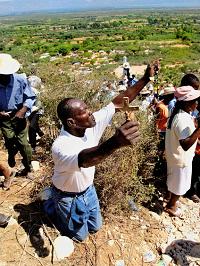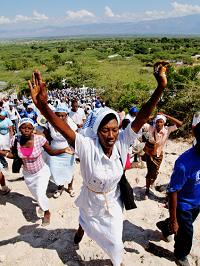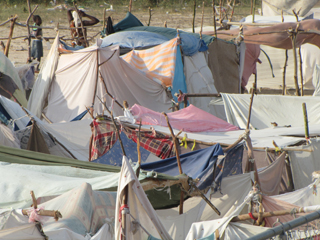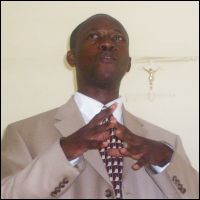The Battle in Haiti for a Town Called Ganthier: Complicity of NGOs in a Land Grab
By Dady Chery
Haiti Chery
If you are a tourist who has explored Haitian cities outside the usual list of recommendations, you would know that Ganthier is a great stop for collectors of Haitian crafts: a beautiful border town in the country’s southeast, peppered with springs, and boasting the country’s largest lake, l’Etang Saumatre. Ganthier’s population is about 80,000 humans, plus countless ducks, geese, and flamingos, and even a fair number of crocodilians. It is a place that begs to be reproduced from the imagination. As one traveling by car, you would certainly have also learned that, contrary to most Haitian roads, the main thoroughfare to Ganthier is paved and passable. A few potholes more, and you are in the Dominican Republic. If you are accustomed to comfort or have a head for business, you might wonder why Ganthier offers no public amenities and collects no tourist fees, though it easily could.
A Haitian would immediately know why this is so, of course, because her first thoughts of Ganthier would be about Calvaire Miracle: a place of pilgrimage. More than 100,000 natives from within the country and without visit this holy site every year. The largest crowds, an odd mixture of vodouists and catholics, arrive on good friday. The serious vodouists walk miles from other holy sites to shed their misfortunes at Calvaire Miracle and steel themselves for a new start. They have come, carrying a stone on their heads, well before the catholic church, in defeat, put its stations of the cross there. This and the other places of pilgrimage have one thing in common: water. Haitian gods are thought to originate from deep beneath the waters. Given current world events, one need not be a voodouist to get carried off by such thoughts. But after the mind returns to more mundane matters, it might recall that Ganthier is a major producer of Haiti’s mangoes, lemons, plus assorted art works, especially sculptures.
Ganthier’s nearest neighbor is the much larger town of Croix-des-Bouquets (pop. 230,000), about 10 kilometers northwest, birthplace of the famous painter Gesner Armand.
Such would be your train of thought if you are past a certain age. If you are younger, you would think instead of the Haitian-born pop star Wyclef Jean, also a native of Croix-des-Bouquets. The young set’s focus would be more appropriate this time.
As it happens Mr. Jean is also the founder of the NGO Yele Haiti. For months, he has appealed to Haitian authorities to identify “unused lands” on which to build 500,000 houses. Proximity to Mr. Jean’s home town, together with an accessibility to the Dominican Republic, among other things, made Ganthier a ideal target for this project. On Monday June 21, 2010, Yele Haiti came to Ganthier with considerable fanfare to visit a 300-acre site where they promised they would soon build 100 out of 1000 houses, and they announced that the Haitian state would make available additional lands for their projects without delay. “The families who will live in these houses will have the means to get started in the agricultural sector.” they boasted, while pointing out that other, much wealthier, NGOs had so far done nothing for the population. They would blaze the trail, they promised, with an ambitious project that will culminate with the construction of 500,000 houses in Ganthier.
Two days later, Ecoworks announced that it too, would undertake several projects in Ganthier.
According to Mrs. Enrika Manes, the director of Ecoworks, this organization, which has been in Haiti for two years, proposes to “develop long-term projects in partnership with local authorities and the Fund for the Development of the Frontier (FDF). Its first project will be to establish an egg farm with 20,000 layers to generate revenue for investment in projects of infrastructure.” Sounds good enough, except for the stench, and the flies, which will go on for miles, and the waste, which I estimate at 2.5 tons of wet manure per day, the pollution of ground water, the waterways, and the fish kills.
Not to be outdone by a rap star and chicken coop, Canada’s minister for international cooperation, Ms. Bev Oda, announced on June 28, 2010 that Canada too will finance a project in Ganthier: the establishment of a police academy, to the tune of $18.1 million U.S. dollars.
The only problem with these plans is that there are no unused lands in Ganthier. The Haitian government cannot promise these lands to anyone because these publicly owned lands are a commons that cannot be sold.
According to an ordinance dated August 19, 2009, and signed by Director General Jean-Frantz Richard:
“The Office of the Director General of Tariffs notifies all public notaries, land surveyors, and other public officers that they are forbidden from conducting all transactions involving the sale or survey of properties belonging to the Haitian State in the commune of Ganthier, and in particular the following areas: Desmarres, Ti Tanyen, lan Borne, Terre Centree, Malpasse, Marre à roseaux, pays Pomas, Quenette (Quinet) descloches, Morne-à-Selle, Poillon, Fonds- Parisien, Bady, Lastic, potiche, Balan, Fon Bayard, By-rhonde, and Dahay.”
Many peasants eke out their living from these lands, and their passionate ownership of it is legitimized by many years, decades, even generations of hard work. As for private lands: there is no place in Haiti where an area vast enough for 500,000 lodgings could be cleared for new construction without many months or years of negotiations. And even if this were possible, it would be foolhardy — even criminal — to pave some of the most arable land in a country rife with hunger, to make way for dwellings. True, there are some arid lands in Ganthier, but this is because, for many years, the government’s budgets have made no provision for maintaining the irrigations canals. Many are clogged. Others destroyed. As a result, arable acreage has been left unirrigated for years, leading to the displacement of many peasants from their homes to the free-trade zones along the border, like those in Ouanaminthe where, several years ago, miles of Haiti’s most fertile lands were buried beneath a pile of concrete. The idea of a free-trade zone along the Haitian-Dominican border is an old one. Yele Haiti surely knows this. After all, Wyclef Jean is no starry-eyed child dreaming of an emerald city but a shrewd businessman who has thrived in the notoriously cuthroat U.S. music industry. He is also politically well connected and the nephew of the current Ambassador to the U.S.
The violence resulting from Yele Haiti’s initiatives were predictable. Since May, a group of peasants have been on the warpath because they are being evicted from lands they have stewarded all their lives. In an attempt to appease them, at the beginning of June, a regional executive repeated the injunction against all transactions involving properties in Ganthier. This served for nothing, apart from inviting the systematic beatings, arrests, and imprisonments of those youths who publicly opposed the land grabs. The worst confrontations happened on Sunday June 20, 2010, the eve of Yele Haiti’s grand entrance.
Undeterred by a high turnout of police and heavily armed private security forces, hundreds of peasants burned three tractors, two trucks, and several police cars. In addition, they pelted the police commissioner’s cars with rocks and tried their best to torch his house. “We torched the heavy machinery to send a clear message to all those who think they can dislodge us from here!” shouted an angry young man.
A wealthy man in the area is being accused of expropriating over 9,000 acres of land and selling the majority of it to high-level members of the police force, former ministers, a former representative of Ganthier in Haiti’s parliament, and the wife of the current Minister. According to the newspapers Haiti Libre and Le Nouvelliste, the culpability of these individuals will require an investigation of the lands’ titles. The press did manage to interview Mr. Galette, who confirmed for them his claim of the ownership of about 5,000 acres of the lands in question and said that he came by them through an inheritance.
Not even Ralph Lapointe, the mayor of Ganthier, was spared the violence of what appeared to be a private mercenary army. Several witnesses confirmed Mr. Lapointe’s statements that he was beaten within sight of a group of policemen who did nothing whatever to help him, and that he was told by one of Mr. Galette’s close associates: “I will find you wherever you go.”

City Hall Director Jean Vivalex Cetoute (L), and originator of computing-center project Brunel Lapointe (R).
The police inspector contradicted the mayor’s statements. “It is false that the mayor was beaten. This is only a pretext to justify acts of vagrancy.” The inspector also denied that some police officials have become owners of the lands.
The Mayor, for his part, went on the record with his accusations of complicity in a land grab against named officials and policemen from Croix-des-Bouquets. He announced that he will formally bring the assault and death threats to the attention of the Minister of Justice. In addition, he made known his intention to proceed with charges against a real estate dealer and a security specialist close to Galette, who according to him, are implicated, respectively, in the kidnapping of a child and the murder of one of the town’s citizens.
The Mayor credits his life to the intervention of the population. He now appeals to the state to ensure his safety.
Who, in the current Haitian “state”, will protect the Mayor Lapointes of the country?
Surely not the “Vichy officials,” who are rapidly filling their coffers with the proceeds from the ongoing land thefts. Warrants went out for the arrest of one man in Ganthier, but this was one of the Mayor’s relatives.
This mayor is more than justified in fearing for his life. Lately, being a regional admistrator, particularly an honest one, has become quite hazardous in Haiti. The coordinator of the Southeastern region, a mother of two and a militant defender of human rights, was buried on June 18, 2010.
The Mayor of Gonaives, a man considered a devoted public servant, even called wise by some, died suddenly on June 22, 2010 during a Port-au-Prince visit and within a week of the appearance of U.S. Southern Command (SouthCom) in his city. On the announcement of his death, UN forces immediately barricaded the Gonaives city hall and took possession of the city records.
A former legislator, who, years ago, characterized the conditions in Haiti’s prisons as being “execrable and scandalous” and, more recently, often lent his voice to the vocal parliamentary minority that opposed Preval’s initiatives, including the Clinton dictatorship called IHRC (Commission International pour la Reconstruction d’Haiti, or Interim Haiti Recovery Commission), was kidnapped on June 27, 2010 and is still missing.
Now that 500 SouthCom, 8,940 U.N. military, 4,391 U.N. police, and untold numbers of mercenaries are in place to buttress the occupation, the gloves have come off. The “soft arm” of the occupation is supplied by the NGOs: modern-day missionaries, a league of settlers who spend their days pontificating to Haitians and their nights fraternizing with mercenaries.
After much balihoo last April about the 11 articles under which the CIRH would operate, and a parliamentary vote that turned out to be bought, three new articles were recently appended to the CIRH charter with complete casualty and without ovesight. Article 12 is most relevant here. In this new article the CIRH gives itself the “full power to deliver proprietary titles and licenses for the construction of hospitals, power companies, ports, and other projects of economic development.” The same article expects each of the country’s ministries to work with the CIRH to accelerate projects that it deems to be of high priority.
Surely, the regional leaders are now learning what the students, senators, and other protesters of a month ago have come to know. There is no longer a legitimate Haitian state to appeal to. Only ordinary Haitians bearing their burdens, churning the depths of the waters with their calls, and steeling themselves for a new start.
UPDATE, July 2, 2010: Ganthier Mayor Ralph Lapointe and his City Hall director, Mr. Jean Vilvalex Cetoute, both of whom had opposed a land grab in their town, were arrested on Thursday July 1, 2010. They were incarcerated, not in Ganthier, but in Croix-des-Bouquets, home town of the rap star Wyclef Jean, head of the NGO Yele Haiti. Mr. Cetoute remains under arrest there despite not being formally charged with any crime. The Mayor, who was released the same evening, has made it known that Mr. Cetoute’s “dossier is more political than judicial.” On Friday, the peasants blocked route de Malpasse, the road to the Dominican republic. There were gunshots all night. By morning, things appeared calm, and the police inspector declared the road cleared. The peasants, in turn, have said they are not yet finished and have reorganized into small groups.
Source: Haiti Chery












Comments
The Battle in Haiti for a Town Called Ganthier: Complicity of NGOs in a Land Grab — No Comments